
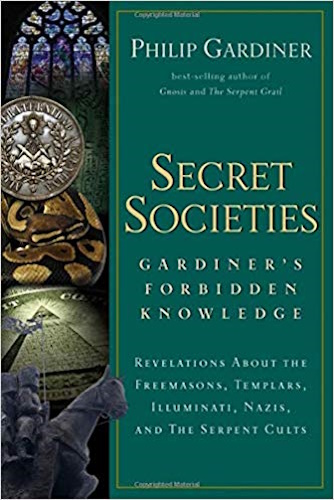



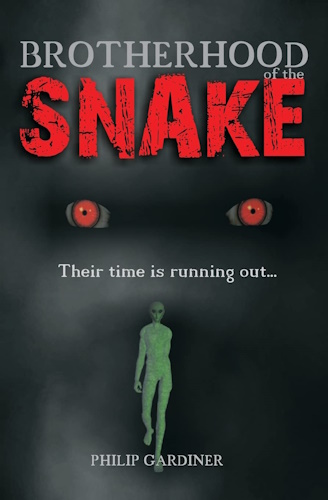



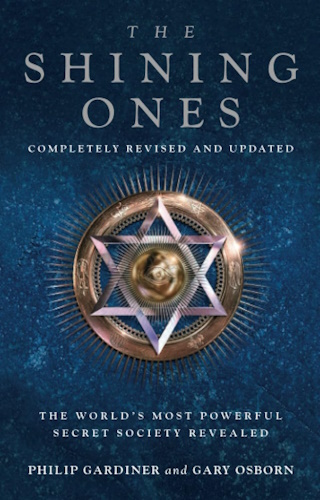

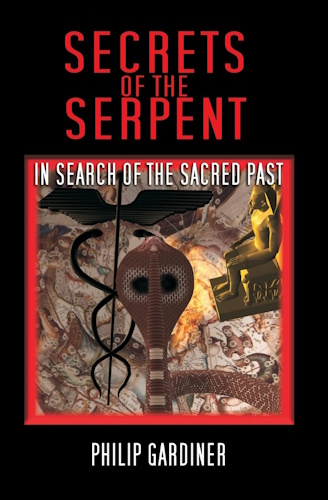

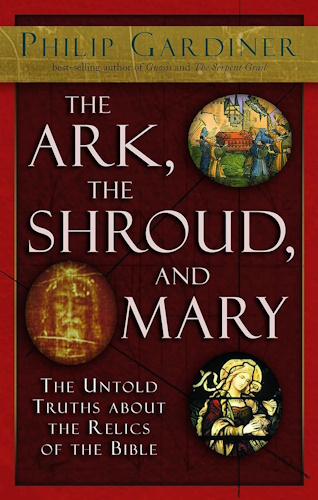


Secret Societies:
Gardiner's Forbidden Knowledge
Revelations About the Freemasons,
Templars, Illuminati, Nazis,
and the Serpent Cults
by
Philip Gardiner
2007
from IndyBay Website
![]()
![]()
6 - The Serpent Sword
When I was first invited to join a certain secret society - one that shall not be found on the Internet - I was amazed at the imagery and symbolism that surrounded me.
On the night of initiation, one particular device set itself apart from all else - the sword.
I was in a long hall that looked like an old chapel, with wooden beams and high windows. The lower parts of the windows were now boarded with finely painted oak - murals depicting the trials and tribulations of a medieval warrior monk. At the end of the hall were large satin curtains of deep red. On either side of me stood a line of men all dressed in white robes, holding aloft gleaming silver swords, and at the end the Grand Master beckoned me "come."
As I walked, the swords fell behind me and were placed zig-zag fashion across the floor so that my path behind was no longer one I could walk. This is a symbolic device, a truth we all must learn - attempting to rewalk the path we have already trodden is pointless.
Eventually, I reached the Grand Master and we followed a ritual that can be dated back many hundreds of years. I bowed low and accepted my pledge as the Master's sword symbolically killed my old self so that I might be born anew.
The sword here is used as a device to bring to life the symbolic aspects of a hidden Gnostic truth and a psychology as relevant today as ever. It has been this way for an awfully long time, and it is interesting, therefore, to discover that King Arthur himself, a symbol of so many things, also held the sword of truth, energy, and wisdom.
In The Quest of the Holy Grail, a uniquely alchemical tale created by secret orders, the sword is seen as a fiery serpent, symbolic of energy. It is the sword of King David or made by the wise Solomon with a pommel stone of all the colors of the Earth and two rib hilts, one made from the fish of the Euphrates, and the other, the serpent.
It is said to resemble the sword of Arthur, which itself is said to be serpentine in the Dream of Rhonabwy.
When Arthur's sword is drawn it was said that two flames of fire burst out of the jaws of the two serpents, and so wonderful was the sword that it was hard for anyone to gaze at it. It is necessary for Arthur to maintain ownership of the sword, whether it is the sword from the stone or Excalibur, as it ensures his victory and his life.
Malory indicates again the brightness of the sword and its fiery aspect, writing:
"but it was so bright in his enemies' eyes, that it gave light like thirty torches."
But the sword in the stone does not last long, and the Lady of the Lake gives Arthur his Excalibur, and also a serpent scabbard, which ensures eternal life. Malory states quite clearly,
"...for whiles ye have the scabbard upon you, ye shall never lose no blood, be ye never so sore wounded; therefore keep well the scabbard always with you."
It is only when Arthur's half sister Morgan le Fay steals the scabbard and replaces it that Arthur becomes susceptible to the deadly blows of Mordred.
The once-prized sword is then returned to the water, the home of the Lady of the Lake - the serpent spirit. There is a remarkable resemblance between the tales of Arthur's sword and Chinese legend.
A hero from the 6th century B.C. named Wu Tzu-hsu threw his sword into a river.
It shot forth like a spirit-glow, sparkling brightly as it thrice sank and thrice came to the surface with a great gush and then hovered above the water. The god of the river…heard the swords roar…he rolled in the waters in a great and frothing frenzy…
Dragons raced along the waves and leaped out of the water. The river god held the sword in his hand and, frightened, told Wu Tzu-hsu to take it back.
(Mair 1983, 141 and 286)
This story, related in the 8th century A.D., simply cannot differ from Malory's tale of the sword.
In China there were tales of great swords such as Dragon Spring and others that leap into waters surrounded by dragons, which churn up the water. Wu Tzu-hsu's sword is also called Dragon Spring.
But is there any archaeological evidence for the existence of a real sword or swords that were seen as serpents? Well, I just so happened to find such evidence in the Catalogue of The Fourteenth Park Lane Arms Fair.
Lee A. Jones authored a fascinating article titled, "The Serpent in the Sword - Pattern-Welding in Early Medieval Swords," which immediately made the hairs on the back of my neck tingle.
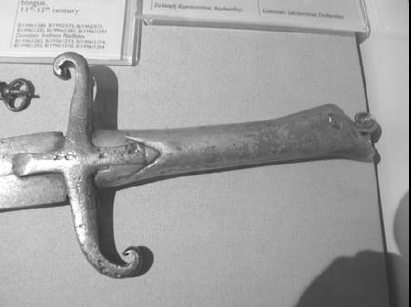
Medieval snake sword
The sword first appeared around 4,000 years ago and immediately became the preeminent weapon, preferred by the warrior class.
Recent metallurgical studies have shown how complex piled structures or layers improved the sword from as early as 500 B.C. in Celtic artifacts. Little wonder that the smithy was an important part of legend and folklore, as the skill implied in the making of these swords is substantial: Several rods are welded together down the length of the blade, joining the various levels of metal together.
It was then heated and pounded into shape. Sword-making was an awesome task. Smaller rods that were carburized (improved carbon) were introduced to increase the hardness.
This formed steel, an alloy of iron with small amounts of carbon, was introduced into the edges of the blade because it was stronger and more effective.
Through the 5th to 10th centuries A.D. - the approximate period of King Arthur - sword smiths actually managed to manipulate this piled structure to create wonderful designs within the blade. The method remained virtually unchanged even into the 20th century, as can be seen with the daggers of the Nazis, who utilized it extensively.
The patterns are seen via the varying degrees of trace elements within the different rods, showing alternating shades. The rods are invariably twisted down the shaft, forming a spiral effect. These "twisted" swords are seen as early as the 1st century B.C. in the La Tene period, although more effectively used from the 3rd and 5thcenturies - the exact early period of Arthur.
Cassiodorus was a secretary of Theodoric, and in A.D. 520 he wrote to a northern Germanic tribe regarding a gift of words praising their skills, especially the shadows and colors seen in the blades, which he likened to "tiny snakes."
The 10th century Kormaks Saga says this concerning the sword Skofnung:
…a covering goes with it and thou shall leave it quiet; the sun must not shine on the upper guard, nor shall thou comest to the fighting place, sit alone, and there draw it. Hold up the blade and blow on it; then a small snake will creep from under the guard; incline the blade and make it easier for it to creep back under the guard.
It is the considered opinion of some scientists that this implies that the dew would reveal the pattern of the serpent upon the sword, giving the impression that a serpent is emerging from the sheath.
This inclusion of the serpent in the blade was eventually replaced with iron inlaid letters and symbols, and Christian phrases such as In Nomine Domini ("In the name of the Lord").
The remarkable archaeological fact of serpents appearing in the designs of 5th century swords links perfectly with the time of Arthur. As the Pendragon or Head/Chief Dragon Lord, he would certainly have been seen with such a device, and in the stories mentioned previously, there are textual links in the legend. Could it be that the tales of Arthur and his serpentine or dragon swords were based upon reality?
And so, coming full circle, I am drawn back to that first initiation years ago and the sword that was bestowed upon me and which is now back with the order. It stood nearly 5 feet with a gold pommel of writhing dragons.
The silver sheen of the blade when turned in the light would reveal a beautiful pattern of two entwined serpents, heads coming closer together as they raced toward the tip.
The sword, as a fighting tool, has been with man for more than 4,000 years, and as such it has crept into the comradeship of the warrior elite that could afford its luxury. Symbolism of wisdom, energy, and illumination has been melded in with the steel structure in the same way that the sword has been melded into the myths and tales that were themselves stories of inner light.
The shining sword is symbolically utilized throughout secret societies today and has been so for hundreds of years - creating a bond between man today and man yesterday.














-
Urantia Book, 44:0.11 - The Celestial Artisans
Never in your long ascendancy will you lose the power to recognize your associates of former existences. Always, as you ascend inward in the scale of life, will you retain the ability to recognize and fraternize with the fellow beings of your previous and lower levels of experience. Each new translation or resurrection will add one more group of spirit beings to your vision range without in the least depriving you of the ability to recognize your friends and fellows of former estates.
-
Princess Bride 1987 Wallace Shawn (Vizzini) and Mandy Patinkin (Inigo Montoya)
Vizzini: HE DIDN'T FALL? INCONCEIVABLE.
Inigo Montoya: You keep using that word. I do not think it means what you think it means. -
Urantia Book, 117:4.14 - The Finite God
And here is mystery: The more closely man approaches God through love, the greater the reality -- actuality -- of that man. The more man withdraws from God, the more nearly he approaches nonreality -- cessation of existence. When man consecrates his will to the doing of the Father's will, when man gives God all that he has, then does God make that man more than he is.
-
Urantia Book, 167:7.4 - The Talk About Angels
"And do you not remember that I said to you once before that, if you had your spiritual eyes anointed, you would then see the heavens opened and behold the angels of God ascending and descending? It is by the ministry of the angels that one world may be kept in touch with other worlds, for have I not repeatedly told you that I have other sheep not of this fold?"
-
Urantia Book, Foreword - 0:12.12 - The Trinities
But we know that there dwells within the human mind a fragment of God, and that there sojourns with the human soul the Spirit of Truth; and we further know that these spirit forces conspire to enable material man to grasp the reality of spiritual values and to comprehend the philosophy of universe meanings. But even more certainly we know that these spirits of the Divine Presence are able to assist man in the spiritual appropriation of all truth contributory to the enhancement of the ever-progressing reality of personal religious experience—God-consciousness.
-
Urantia Book, 1:4.3 - The Mystery Of God
When you are through down here, when your course has been run in temporary form on earth, when your trial trip in the flesh is finished, when the dust that composes the mortal tabernacle "returns to the earth whence it came"; then, it is revealed, the indwelling "Spirit shall return to God who gave it." There sojourns within each moral being of this planet a fragment of God, a part and parcel of divinity. It is not yet yours by right of possession, but it is designedly intended to be one with you if you survive the mortal existence.
-
Urantia Book, 1:4.1 - The Mystery Of God
And the greatest of all the unfathomable mysteries of God is the phenomenon of the divine indwelling of mortal minds. The manner in which the Universal Father sojourns with the creatures of time is the most profound of all universe mysteries; the divine presence in the mind of man is the mystery of mysteries.
-
Urantia Book, 1:4.6 - The Mystery Of God
To every spirit being and to every mortal creature in every sphere and on every world of the universe of universes, the Universal Father reveals all of his gracious and divine self that can be discerned or comprehended by such spirit beings and by such mortal creatures. God is no respecter of persons, either spiritual or material. The divine presence which any child of the universe enjoys at any given moment is limited only by the capacity of such a creature to receive and to discern the spirit actualities of the supermaterial world.
-
Urantia Book, 11:0.1 - The Eternal Isle Of Paradise
Paradise is the eternal center of the universe of universes and the abiding place of the Universal Father, the Eternal Son, the Infinite Spirit, and their divine co-ordinates and associates. This central Isle is the most gigantic organized body of cosmic reality in all the master universe. Paradise is a material sphere as well as a spiritual abode. All of the intelligent creation of the Universal Father is domiciled on material abodes; hence must the absolute controlling center also be material, literal. And again it should be reiterated that spirit things and spiritual beings are real.
-
Urantia Book, 50:6.4 - Planetary Culture
Culture presupposes quality of mind; culture cannot be enhanced unless mind is elevated. Superior intellect will seek a noble culture and find some way to attain such a goal. Inferior minds will spurn the highest culture even when presented to them ready-made.
-
Urantia Book, 54:1.6 - True And False Liberty
True liberty is the associate of genuine self-respect; false liberty is the consort of self-admiration. True liberty is the fruit of self-control; false liberty, the assumption of self-assertion. Self-control leads to altruistic service; self-admiration tends towards the exploitation of others for the selfish aggrandizement of such a mistaken individual as is willing to sacrifice righteous attainment for the sake of possessing unjust power over his fellow beings.
-
Urantia Book, 54:1.9 - True And False Liberty
How dare the self-willed creature encroach upon the rights of his fellows in the name of personal liberty when the Supreme Rulers of the universe stand back in merciful respect for these prerogatives of will and potentials of personality! No being, in the exercise of his supposed personal liberty, has a right to deprive any other being of those privileges of existence conferred by the Creators and duly respected by all their loyal associates, subordinates, and subjects.
-
Urantia Book, 54:1.8 - True And False Liberty
There is no error greater than that species of self-deception which leads intelligent beings to crave the exercise of power over other beings for the purpose of depriving these persons of their natural liberties. The golden rule of human fairness cries out against all such fraud, unfairness, selfishness, and unrighteousness.




